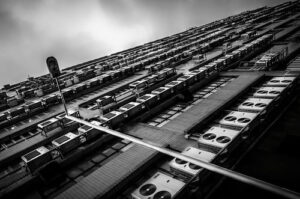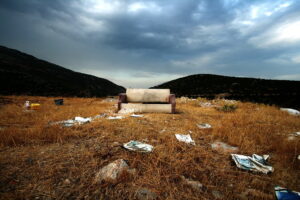Green futures: a masterclass in inclusive, sustainable community placemaking
Sarah Nelson, CEO at Foundation for Future London, explains how listening to residents, responding to specific needs, and providing broader access to diverse demographics are essential to the success of environmentally-aligned urban development.

Gaia’s Garden, Play Nice and Dominvs. Photographer: Francis Augusto
The current climate emergency directly affects lower-income communities in urban places, many of which are already marked by economic, health, and social inequalities. Recent extremes in temperature — particularly sustained heatwaves — have compounded issues in numerous London boroughs and other urban areas around the UK. Add to this the fact that lower-income communities have less access to open green spaces to escape the heat and the scale of the problem becomes clear.
Many of these communities are confined to smaller living spaces in general, exacerbating the issue. Some 6million people live in vulnerable situations in the UK, often in densely built-up areas that experience higher temperatures during heatwaves influenced by climate change. London, in particular, has the highest poverty rate in the UK. However, there are significant disparities between boroughs. Tower Hamlets and Newham have poverty rates higher than the London average (12 and 8 per cent higher respectively), but Richmond upon Thames is 16 per cent lower.
Many of these lower-income areas – take much of East London as an example – are already undergoing rapid transformation. They have seen developments such as Queen Elizabeth Olympic Park and the new East Bank cultural quarter. Newham particularly boasts plenty of land that is ready for development, along with top-tier transport and digital infrastructure.
But it’s crucial that the voices of the people who live there are heard and that they are provided with opportunity to shape the future of built and natural environments, especially as we start to see greater impacts of climate change. Placemaking is a powerful tool that can be used to ensure a sustainable future in low-income areas. But how can governments, policy-makers, businesses, and communities prioritise sustainable development with this approach?
The climate crisis and lower-income community vulnerability
The climate crisis is affecting lower-income communities in varied ways. Lower-income communities across the UK are facing many of the same challenges: the results of underinvestment and sometimes short-sighted planning. Many challenges fall on top of the others, making them even harder to manage.
There are real-world consequences. High levels of air pollution, in particular, can have a dramatic effect on the health of a community. Research shows that not only are young people in high-pollution areas at greater risk of diseases such as asthma, pulmonary disease and even potentially dementia, but they’re also more likely to suffer from mental health problems such as depression and tend to not perform as well academically.
Air pollution is the UK’s biggest environmental health threat, with outdoor pollutants estimated to contribute towards 40,000 excess premature deaths annually, costing the UK economy upwards of £20 billion. One in seven of Newham’s population is exposed to levels of Nitrogen dioxide (NO2) that are above the UK limit value for human health.
Newham also has one of the largest Black, Asian and People of Colour (BPOC) populations. The problem is not confined, either, with one-third of London’s schools found to be close to busy roads producing illegal levels of NO2 pollution.
While many of these problems are multifaceted and intertwined, we need to look to the sustainable development of urban spaces as an answer. And placemaking is a key element.
Placemaking as a solution
Placemaking refers to community-first planning, design, and management of public spaces. It creates areas that reflect and meet the needs of a community, promote social interaction and well-being, and are economically viable and sustainable. Good placemaking makes use of otherwise underutilised spaces and enhances the urban experience of local people.
Placemaking can play a huge role in greening urban areas, which brings health benefits to local communities. Parks, urban forests, tree-lined streets, and riverbanks, for example, all support urban well-being by providing space for rest, relaxation and exercise.
Effective placemaking involves creating public green spaces that are accessible to all, and that offer the chance for residents to contribute to their design and development. In addition to its positive impact at the individual level, placemaking projects can inspire feelings of inclusivity, empowerment, and civic pride.
The Green Up Newham Project is a good example of a practical initiative that creates green space, increases social engagement, and provides opportunities for growing and farming for the community. Funded as part of Foundation for Future London’s Small Grant Scheme in partnership with Westfield Stratford City, the scheme uses economic gardening and local diversity to inspire, promote and develop a local talent pool with the aim of creating a sensory garden in Newham.
Ultimately, the aim is to encourage young people’s wellbeing and participation, but a key part of their vision was also addressing the lack of diversity in environmental projects. Through this, young people from BPOC communities were supported in taking the lead on efforts in their community, giving a sense of pride and social inclusion.
Black, Asian and ethnically diverse communities disproportionately face the challenges of green poverty, yet their representation and involvement in environmental discussions, events and projects remains limited. This approach sought to provide opportunities for young individuals from these communities to take the lead on an environmental project, allowing them to witness development from concept to completion.
Creating public spaces in urban areas has huge social and cultural effects on communities, creating authentic relationships and instilling a sense of ownership in public spaces, which have been gentrified. In East London, for example, the sustainable redevelopment of land around the Olympic Park has led to a rejuvenation of arts and culture in the area. Through partnerships across the East Bank, more than 2,500 jobs will be created, as well as the opening of new University of the Art’s London and University College London campuses, V&A East, and a state-of-the-art BBC music studio.
Another example is the Royal Docks, also in Newham, which has become a thriving hub for both businesses and cultural activities within the borough. This regeneration project focuses on revitalising the waterfront and is a collaborative effort between the Mayor of London and the Mayor of Newham. It’s a prime example of effective stakeholder engagement and community involvement, resulting in numerous benefits for the area. It not only offers spaces for local communities to gather but for cultural events to take place, enriching the sense of community by providing a place for residents to experience arts and culture locally.
Collaboration for sustainable development
For sustainable development to be successful, it needs to create positive outcomes for people locally and globally. This can include providing them with a healthier, greener space to live in, encouraging them to have a voice and listening to their ideas shaping the redeveloped spaces or allowing them to develop new skills.
But none of this is possible without large-scale collaboration between governments, authorities, community organisations and businesses. Policymakers have a crucial role to play in promoting and implementing sustainable placemaking practices. They have the power to shape policies and regulations that incentivise and prioritise sustainable development, ensuring that placemaking projects are environmentally friendly, economically viable, and socially inclusive of those they affect.
These developments must also be in line with the targets to create transformative social, economic, and environmental progress as part of the UN Sustainable Development Goals [SDGs] – which act as part of a global sustainability strategy. It’s through a participatory approach to urban planning that placemaking encourages individuals to become active agents of change in their own communities, promotes sustainable business models, and makes the targets outlined in the UN’s SDGs more attainable.
This involves having an open conversation about how to design communities specifically based on people’s needs and wants and giving individuals a chance to direct their skills and expertise into tangible solutions. After all, it’s inclusivity that will enhance the effectiveness and reach of environmental projects and help to break down systemic disparities.
There are of course barriers that might prevent this, including language, childcare, and education, and not least the fact profit is more important to big business than the planet or its people. But there needs to be true transparency and a rebalancing of power to allow communities to build sustainable urban spaces for the present and the future.
A more sustainable future
Using placemaking to design and develop more sustainable urban spaces has been shown to have an outsized effect on local communities. It addresses the lack of green spaces and enhances community well-being. And with the climate crisis set to become more urgent, lower-income areas need investment to guarantee the safety and well-being of residents. Projects seen in boroughs like Newham demonstrate the positive impact of placemaking.
Collaboration among policymakers, communities, and businesses is essential in promoting and implementing sustainable placemaking practices. Through a collaborative approach to sustainable development, we can ‘create transformative social, economic and environmental progress’ as outlined in the UN’s SDGs, and provide present and future generations urban spaces that mitigate the effects of climate change and encourage health and wellbeing.
More features:
Predicting the unpredictable: modelling extreme weather in a changing climate
Quick question: What does organisational sustainability look like in 2024?
Subtle shades: Hidden greenwashing and how to avoid it in 2024
Images:















